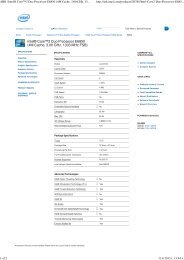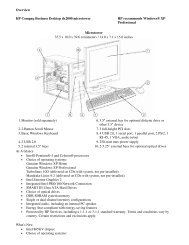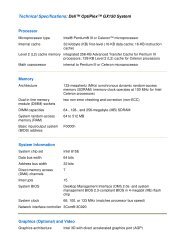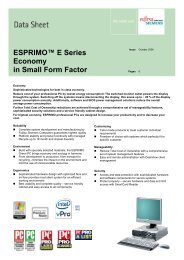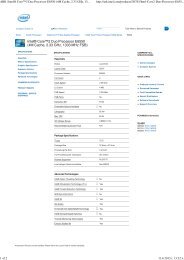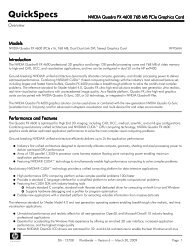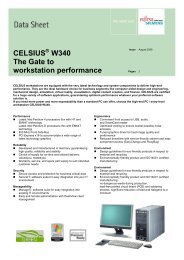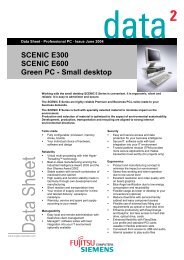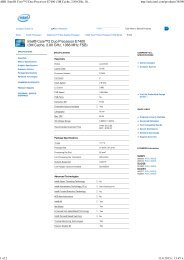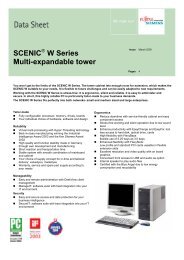(ARK | Intel\256 Core\2312 Duo Processor E7200 \(3M Cache, 2.53 ...
(ARK | Intel\256 Core\2312 Duo Processor E7200 \(3M Cache, 2.53 ...
(ARK | Intel\256 Core\2312 Duo Processor E7200 \(3M Cache, 2.53 ...
Create successful ePaper yourself
Turn your PDF publications into a flip-book with our unique Google optimized e-Paper software.
<strong>ARK</strong> | Intel® Core2 <strong>Duo</strong> <strong>Processor</strong> <strong>E7200</strong> (<strong>3M</strong> <strong>Cache</strong>, <strong>2.53</strong> GHz, 10... http://ark.intel.com/products/35348/Intel-Core2-<strong>Duo</strong>-<strong>Processor</strong>-E720...<br />
The Recommended Customer Price (“RCP”) is pricing guidance for Intel products. Prices are for direct Intel customers and are subject to change without notice. Taxes and shipping, etc. not included. Prices may<br />
vary for other package types and shipment quantities, and special promotional arrangements may apply. Listing of these RCP does not constitute a formal pricing offer from Intel. Please work with your appropriate<br />
Intel representative to obtain a formal price quotation.<br />
"Intel classifications" consist of Export Control Classification Numbers (ECCN) and Harmonized Tariff Schedule (HTS) numbers. Any use made of Intel classifications are without recourse to Intel and shall not be<br />
construed as a representation or warranty regarding the proper ECCN or HTS. Your company may be the exporter of record, and as such, your company is responsible for determining the correct classification of<br />
any item at the time of export.<br />
Intel processor numbers are not a measure of performance. <strong>Processor</strong> numbers differentiate features within each processor family, not across different processor families. See http://www.intel.com/content/www/us<br />
/en/processors/processor-numbers.html for details.<br />
Hyper-Threading Technology (HT Technology) requires a computer system with an Intel® processor supporting HT Technology and an HT Technology enabled chipset, BIOS and operating system. Performance<br />
will vary depending on the specific hardware and software you use. See http://www.intel.com/content/www/us/en/architecture-and-technology/hyper-threading/hyper-threading-<br />
technology.html?wapkw=hyper+threading for more information including details on which processors support HT Technology.<br />
64-bit computing on Intel® architecture requires a computer system with a processor, chipset, BIOS, operating system, device drivers and applications enabled for Intel® 64 architecture. <strong>Processor</strong>s will not<br />
operate (including 32-bit operation) without an Intel 64 architecture-enabled BIOS. Performance will vary depending on your hardware and software configurations. Consult with your system vendor for more<br />
information.<br />
Max Turbo Frequency refers to the maximum single-core frequency that can be achieved with Intel® Turbo Boost Technology, which requires a PC with a processor with Intel Turbo Boost Technology capability. Intel<br />
Turbo Boost Technology performance varies depending on hardware, software, and overall system configuration. Check with your PC manufacturer on whether your system delivers Intel Turbo Boost Technology.<br />
See www.intel.com/technology/turboboost/ for more information.<br />
Intel® Identity Protection Technology (Intel® IPT) requires a combination of processor, PCH (Platform Controller Hub) and software. Check http://ipt.intel.com/Home.aspx for systems that support Intel IPT.<br />
Graphics output, multiple displays, ECC memory, specific PCI Express configurations, Intel® vPro Technology, Intel® Trusted Execution Technology, and Intel® Virtualization Technology for Directed I/O (VT-d)<br />
may not be available on all computing systems. Please reference the system, motherboard or chipset specifications for compatibility.<br />
Enabling Execute Disable Bit functionality requires a PC with a processor with Execute Disable Bit capability and a supporting operating system. Check with your PC manufacturer on whether your system<br />
delivers Execute Disable Bit functionality.<br />
Intel® Virtualization Technology requires a computer system with a processor, chipset, BIOS, virtual machine monitor (VMM) and for some uses, certain platform software, enabled for it. Functionality, performance<br />
or other benefit will vary depending on hardware and software configurations. Intel Virtualization Technology-enabled VMM applications are currently in development.<br />
System and Maximum TDP is based on worst case scenarios. Actual TDP may be lower if not all I/Os for chipsets are used.<br />
All information provided is subject to change at any time, without notice. Intel may make changes to manufacturing life cycle, specifications, and product descriptions at any time, without notice. The information<br />
herein is provided "as-is" and Intel does not make any representations or warranties whatsoever regarding accuracy of the information, nor on the product features, availability, functionality, or compatibility of the<br />
products listed. Please contact system vendor for more information on specific products or systems.<br />
Low Halogen: Applies only to brominated and chlorinated flame retardants (BFRs/CFRs) and PVC in the final product. Intel components as well as purchased components on the finished assembly meet JS-709<br />
requirements, and the PCB / substrate meet IEC 61249-2-21 requirements. The replacement of halogenated flame retardants and/or PVC may not be better for the environment.<br />
Some products can support AES New Instructions with a <strong>Processor</strong> Configuration update, in particular, i7-2630QM/i7-2635QM, i7-2670QM/i7-2675QM, i5-2430M/i5-2435M, i5-2410M/i5-2415M. Please contact<br />
OEM for the BIOS that includes the latest <strong>Processor</strong> configuration update.<br />
*Trademarks<br />
©Intel<br />
Corporation<br />
2 of 2 25.6.2013 г. 15:29 ч.




